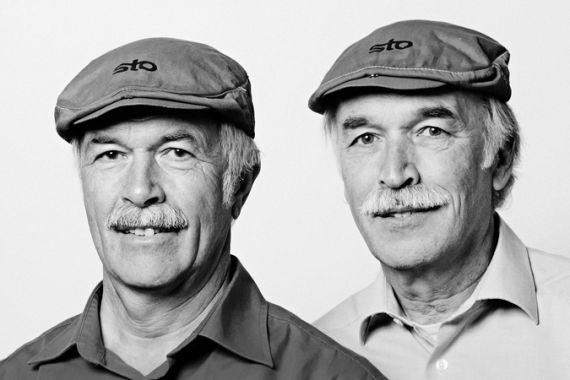Canada photographer looks out for lookalikes
Francois Brunelle has photographed almost 200 pairs of lookalikes around the world for ongoing art project.

What if we weren’t unique?
What if, somewhere, someplace, there was someone who looked just like each of us – what German speakers might call a doppelganger, a lookalike?
Keep reading
list of 4 itemsPalestinian Prisoner’s Day: How many are still in Israeli detention?
‘Mama we’re dying’: Only able to hear her kids in Gaza in their final days
Europe pledges to boost aid to Sudan on unwelcome war anniversary
That’s the possibility that drives the work of Francois Brunelle, a photographer based in Montreal, Quebec. As part of an ongoing art project, he has found, tempted into his studio and photographed nearly 200 pairs of lookalikes. Most didn’t know each other before he clicked their pictures.
“It’s not just the looks, the appearance,” Brunelle says, “it’s a way of being, the way people stand, hold themselves, walk, sit, talk even”.
Two events got his project started.
“I was in a bank and behind the counter, I saw what I thought was the husband of a friend and I was surprised that he was working in a bank. He’s not supposed to work here,” he recalls.
Brunelle walked up to the man and asked him why he’d changed jobs. It wasn’t until the two spoke for a few minutes that the photographer realised he had the wrong man. “A few months later, I got him together with my friend’s husband and they were my among my first sets of lookalikes.”
Mr Bean’s brother
A resemblance shared by Brunelle himself was the second inspiration for the project. “People told me for years that I looked like Mr Bean but I didn’t know what they meant. I always wondered if they thought I looked like a bean?”
Then he finally saw the iconic British comedy programme on television and admits to being somewhat shocked that he bore any similarities to the notorious stumblebum played by comedian Rowan Atkinson.
“I used to wear a tie all the time myself and I realised ‘oh my God, I do look like this guy. I don’t want to be this guy’,” he says, shaking his head.
Later, Brunelle did find a possibly more respectable lookalike, a popular Montreal actor who’s 15 cm. taller and younger, but seems to share that “way of being” the photographer talks about.
“I’ve had bartenders at the theatre give me what he usually drinks,” says the photographer, “and when we finally met and I took our pictures, we became friends”.
Befriending lookalikes
That’s a big part of the project – which Brunelle somewhat playfully calls “I am not a lookalike” – bringing people together who didn’t know each other at all, or who were aware of the resemblance, but hadn’t met until art intervened.
Gabrielle Lamoureux and Alana Pipe are in the latter category. Both are students in their 20s who found each other through social media and real-life friends.
Sitting together after their photo shoot with Brunelle, they laugh and complete each other’s sentences and seem to be twin sisters, even though they’re from different parts of Canada. “Two years ago, you moved into the apartment I used to have in Montreal,” says Gabrielle, known as Gaby to her friends. “Didn’t you take my old room?”
Alana jumps in. “No, it wasn’t that, but all your friends became my friends and they all said we looked alike. Even then I didn’t think about it much.”
Gaby again: “So there I was living in Calgary and I was on Facebook looking up Montreal friends and I saw a picture of myself at a party and I thought, ‘wait a minute’. That can’t be. I wasn’t there, I was here.”
Gaby sent Alana a message and a friend request on Facebook and a year later moved back to Montreal where she met the woman she calls her “twin”.
“My sister doesn’t look anything like me,” she tells Alana, “You look more like my sister than my sister does. It’s kind of eerie but cool too.”
Sharing fascination
In their photo shoot, the two young women wore similar clothes, but Brunelle says that’s not important. He encourages his models to wear whatever they please.
He’s photographed lookalikes from different ethnic backgrounds and matched men and women who look startlingly similar.
A statistician once told him there were probably 200 “types” of faces in the world, but he’s not sure about that. “It’s about the angle, the closeness, the looks on the faces, it’s all a bit of mystery really,” he says. ”This project isn’t about solving that mystery either. I’m not into that. I just to share my fascination. I don’t want any answers. I just want people to look at what we’re doing here.”
On a table in his studio are dozens of print-outs from emails he’s received from around the world. Off to one side, next to a folder of mails from people who think they look like celebrities, is a file marked “Bizarre”.
“Here’s one from a woman in China who wants me to find her lookalike,” he says. “She says she feels alone and wants to be less lonely. I wish I could help her but I can’t. People want this, you know, they want to be part of this. I may stop when I’ve got around 200 pairs but someone should keep going. Maybe we all should have a lookalike.”
Even if it’s Mr Bean.